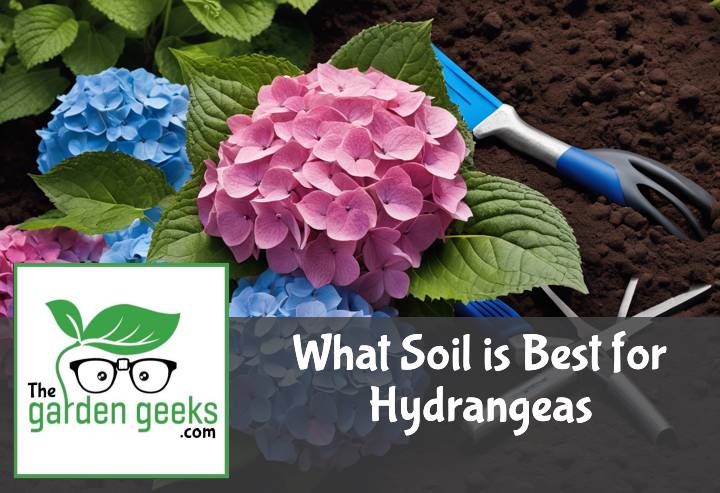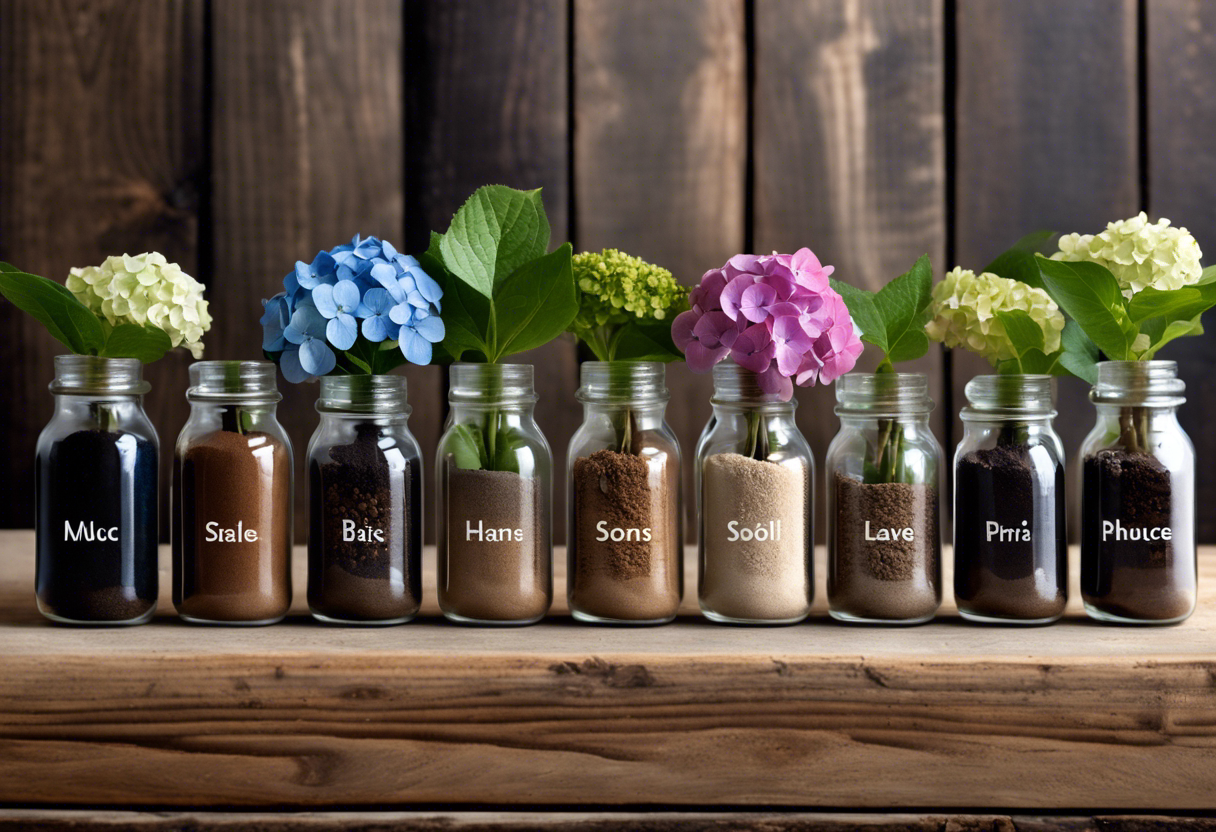Ah, the Soil for Hydrangeas dilemma! It’s a puzzle that has perplexed many a green thumb and garden enthusiast. You see, hydrangeas are like the Goldilocks of the plant world – they need their soil to be just right.
But fear not, my fellow plant lovers! We’re about to embark on a journey of dirt and petals to discover what makes the perfect soil mix for these blooming beauties. So buckle up your garden gloves and let’s dig in! Shall we keep reading about ‘What Soil is Best for Hydrangeas?’
Key Takeaways
- Hydrangeas thrive best in loamy soil, which provides a balance of drainage and moisture retention.
- The soil pH should be acidic (pH 5.5) for blue hydrangeas and alkaline (pH 6.5) for pink ones.
- Organic matter like compost or well-rotted manure can enhance the soil’s fertility.
- Mulching helps to maintain soil moisture and temperature, benefiting hydrangea growth.
- Regular soil testing is recommended to monitor nutrient levels and pH balance.
Understanding Hydrangeas
Hydrangeas are more than just pretty faces in the garden. They’re hardy, versatile, and oh-so-charming. But their beauty isn’t skin-deep. These plants have a secret weapon: the soil they grow in.
What are Hydrangeas?
Hydrangeas, my friend, are a gardener’s dream! Known for their large, vibrant blooms that can range from pink to blue to white, these plants are a sight for sore eyes. They come in different types too – like the bigleaf hydrangea or the smooth hydrangea. Each one has its own unique appearance and charm.
But here’s a fun fact: The color of some hydrangea plant characteristics can actually change based on the soil’s acidity level! Talk about being high maintenance, right? But don’t worry – it’s this very trait that adds to the popularity of hydrangeas among garden enthusiasts.
Why is Soil Important for Hydrangeas?
Now let’s get down and dirty with some science. You see, soil for hydrangeas is like food for us humans – it provides them with all the nutrients they need to grow and thrive.
The right kind of soil can make a world of difference to your hydrangea’s health. It affects everything from how well they absorb water and nutrients to their resistance against diseases. In short, if you want your hydrangeas to be happy and healthy, you’ve got to pay attention to their diet… I mean soil!
So there you have it folks! The secret behind those beautiful blooms isn’t just good genes but also good dirt! Remember this golden rule: Happy soil equals happy hydrangeas!
Types of Soil
When it comes to soil for hydrangeas, not all dirt is created equal. Different soil types have unique characteristics that can significantly impact your hydrangea’s growth and health.
Clay Soil
Let’s start with clay soil, shall we? This type of soil is known for its compact nature. It’s like the overprotective parent of soils – it holds onto water and nutrients tightly, making it harder for plants to access them. Now, you might be wondering how this affects our beloved hydrangeas. Well, because of these clay soil properties, hydrangeas may struggle a bit in this environment.
You see, while they love a good drink, too much water can lead to root rot. And since clay soil doesn’t drain well, it can create a soggy situation that your hydrangeas won’t appreciate. So, is clay soil suitable for hydrangeas? In small amounts, sure! But as the main soil for hydrangeas, it might not be the best choice.
Sandy Soil
Moving on to sandy soil now. Picture a day at the beach – loose and free-flowing sand under your toes. That’s pretty much what sandy soil feels like! It drains quickly and doesn’t hold onto nutrients well due to its coarse texture. How does this translate into sandy soil and hydrangeas?
Well, while good drainage prevents water-logging (yay!), the fast nutrient loss can leave your plants hungry (not so yay!). Hydrangeas need a balanced diet just like us humans do! So again, is sandy soil appropriate for planting hydrangeas? It could work if you’re diligent about watering and fertilizing but isn’t ideal.
Loamy Soil
Last but certainly not least: loamy soil! This superstar of soils has got it all: good structure, excellent drainage, and a knack for holding onto just the right amount of nutrients. It’s like the Goldilocks of soils – not too heavy, not too light, but just right! So how does this loamy soil affect hydrangeas?
Well, in short, they love it! The balanced nature of loamy soil provides an ideal environment for hydrangeas to thrive. It offers them easy access to water and nutrients without drowning their roots or leaving them hungry. So is loamy soil an ideal choice for planting hydrangeas? You betcha! Your hydrangeas will thank you for it.
Ideal Soil Conditions for Hydrangeas
When it comes to soil for hydrangeas, it’s not just about shoveling some dirt and calling it a day. Oh no, these beauties need a bit more TLC. We’re talking pH levels, nutrients, and drainage.
pH Level Requirement
Now, let’s get down to the nitty-gritty. The hydrangea pH level is like the Goldilocks of soil acidity for hydrangeas – not too high, not too low, but just right. Ideally, you want something around 5.5 to 6.5.
But here’s the fun part: playing with the pH can actually change your hydrangea color! It’s like magic…or science…or both! Alkaline soil and hydrangeas will give you pink blooms while more acidic soil turns them blue.
Nutrient Requirements
Moving on to the buffet line – hydrangea nutrient needs. These plants love their food! Essential nutrients for hydrangeas include nitrogen for leaf growth and phosphorus and potassium for flower development.
Fertilizing hydrangeas can be a game-changer in getting those big, beautiful blooms everyone loves. Just remember that a nutrient-rich soil for hydrangeas is like a well-balanced diet – too much of one thing isn’t always good.
Drainage Needs
Last but certainly not least: drainage. Hydrangea drainage needs are pretty straightforward – they don’t like wet feet! Waterlogged soil and hydrangeas are about as compatible as cats and water.
Improving soil drainage for hydrangeas can be as simple as adding organic matter or sand to your soil. Remember folks, when it comes to watering these plants, think “Goldilocks” again: not too dry, not too soggy, just right!
How to Prepare the Best Soil for Hydrangeas?
Alright, let’s dive into the nitty-gritty of preparing soil for hydrangeas. This process involves testing and adjusting pH levels, adding necessary nutrients, and ensuring proper drainage.
Testing and Adjusting the pH Level
First off, you need to test your soil’s pH level. Hydrangeas are a bit picky when it comes to acidity or alkalinity in their soil. They prefer slightly acidic conditions. So, grab a soil pH testing kit from your local garden store and get down to business.
Once you’ve got your results, it’s time for some adjustments. If your soil is too acidic or too alkaline, don’t panic! You can change its acidity with some lime or sulfur. Remember, the ideal pH for hydrangeas is between 5 and 6.
Adding Necessary Nutrients
Next up on our hydrangea soil preparation journey is nutrient addition. These blooming beauties need a good mix of essential nutrients to thrive. Nitrogen, phosphorus, potassium – they love ’em all!
To add these nutrients to your soil, consider using a balanced fertilizer or compost rich in organic matter. Your hydrangeas will thank you with lush growth and vibrant blooms when they’re planted in this nutrient-rich soil for hydrangeas.
Ensuring Proper Drainage
Finally, we come to drainage – an often overlooked but crucial aspect of creating the best soil for hydrangeas. These plants aren’t fans of waterlogged roots; they prefer their feet (or rather roots) dry!
To ensure proper drainage in your garden, consider adding coarse sand or grit to heavy soils. This helps prevent waterlogging and provides optimal hydration for your hydrangeas. And voila! You’ve got yourself the perfect setup for growing happy, healthy hydrangeas.
Common Mistakes in Choosing Soil for Hydrangeas
When it comes to hydrangea care, the soil can make or break your success. It’s not just about shoveling some dirt and calling it a day. Nope, there are some common hydrangea soil mistakes that can turn your blooming beauties into sad shrubs.
Overlooking pH Levels
One of the biggest blunders is overlooking the importance of pH levels. Hydrangeas aren’t just picky about their soil; they’re downright divas! They have a specific hydrangea pH preference.
If you’re not mindful of the soil acidity for hydrangeas, you could end up with a garden full of lackluster blooms. And nobody wants that, right? So remember, when choosing hydrangea soil, don’t forget to consider the pH level.
Ignoring Nutrient Content
Another common error is ignoring the nutrient content of the soil. Just like us humans, hydrangeas need a balanced diet to thrive. If they don’t get their essential nutrients, they won’t grow properly.
Hydrangeas have specific nutrient needs that differ from other plants. So if you want those big, beautiful blooms, make sure your soil is rich in nutrients – specifically tailored for hydrangeas.
Neglecting Drainage
Lastly, let’s talk about drainage. You might think more water equals happier plants but overwatering can lead to waterlogged roots and unhealthy plants.
Hydrangeas need well-drained soil to prevent root rot and disease. So if you’re neglecting proper drainage when choosing your hydrangea soil, you might be setting yourself up for failure.
Remember folks, gardening isn’t just about having a green thumb; it’s also about using your noggin! Don’t overlook these crucial factors when choosing the right soil for hydrangeas.
To Wrap Up
Just as you wouldn’t feed a racehorse the same grub as a goldfish, Hydrangeas also have their preferred diet. They crave soil that’s like a five-star buffet – rich, well-draining with a slightly acidic pH.
So, if you’re ready to roll up your sleeves and get down and dirty, check out this comprehensive guide on Soil for Hydrangeas. Your hydrangeas will thank you with a spectacular show of blooms!





